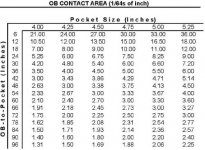Can someone point me to a thread or a web site that discusses the size of the contact point for different angles and the margin of error for different distances.
I am looking for the margin of error for different shots over different distances.
For instance on a straight in shot the size of the contact point is .xx while on a 30 degree cut shot the size of the contact point is .xx
On a 30 degree cut shot that is 6" from the pocket the contact point is .xx with .yy margin of error.
On a 30 degree cut shot that is 24 inches from the corner pocket the size of the contact point is .xx with .yy margin of error on a standard table with zz size pockets.
What I am attempting to determine is how accuate the player must be in order to make different shots. While this has probably been combined into a degree of difficulty equation that is not what I am looking for.
What I am attemptng to do is to state how accurate one must be to make X shot. Somthing like, "The player must hit within 1/64 of an inch of the correct aiming lines to make xx shot over yy distance with the CB at zz distance."
To make my point, I think that all I really need is some estimate of the margin of error for something like a 30 degree cut shot with OB 24 inches from a 4.5 inch pocket and the cb 36 inches away from the OB. One must aim the CB at a contact point that is x in diameter.
The reason for my request is that I have an idea about how the mind aims a shot that I will present here on AZB but to make the argument I need to precede it with the accuracy requirements to make a particular shot.
Nothing like jumping into the aiming controversy. Of course my perspective is that of psychology, not physics. I suspect the physics guys and others will take me to task so I need to be prepared.
Any help is appreciated.
I am looking for the margin of error for different shots over different distances.
For instance on a straight in shot the size of the contact point is .xx while on a 30 degree cut shot the size of the contact point is .xx
On a 30 degree cut shot that is 6" from the pocket the contact point is .xx with .yy margin of error.
On a 30 degree cut shot that is 24 inches from the corner pocket the size of the contact point is .xx with .yy margin of error on a standard table with zz size pockets.
What I am attempting to determine is how accuate the player must be in order to make different shots. While this has probably been combined into a degree of difficulty equation that is not what I am looking for.
What I am attemptng to do is to state how accurate one must be to make X shot. Somthing like, "The player must hit within 1/64 of an inch of the correct aiming lines to make xx shot over yy distance with the CB at zz distance."
To make my point, I think that all I really need is some estimate of the margin of error for something like a 30 degree cut shot with OB 24 inches from a 4.5 inch pocket and the cb 36 inches away from the OB. One must aim the CB at a contact point that is x in diameter.
The reason for my request is that I have an idea about how the mind aims a shot that I will present here on AZB but to make the argument I need to precede it with the accuracy requirements to make a particular shot.
Nothing like jumping into the aiming controversy. Of course my perspective is that of psychology, not physics. I suspect the physics guys and others will take me to task so I need to be prepared.
Any help is appreciated.
